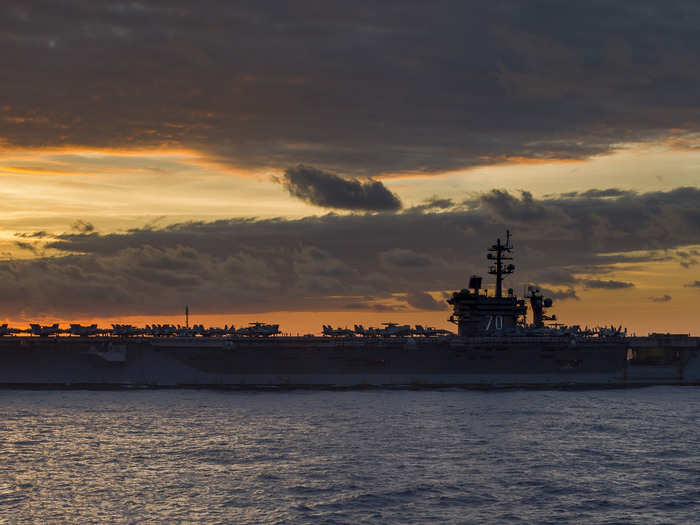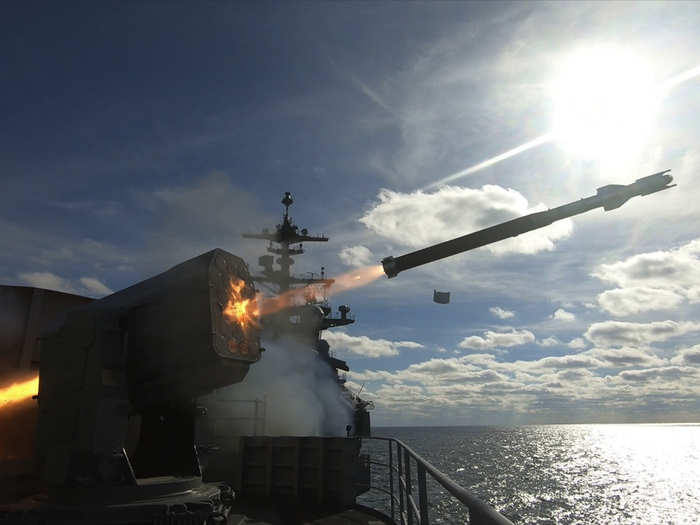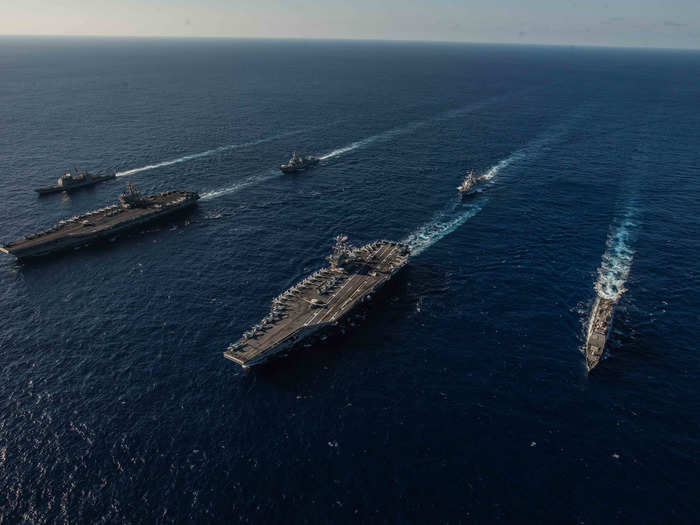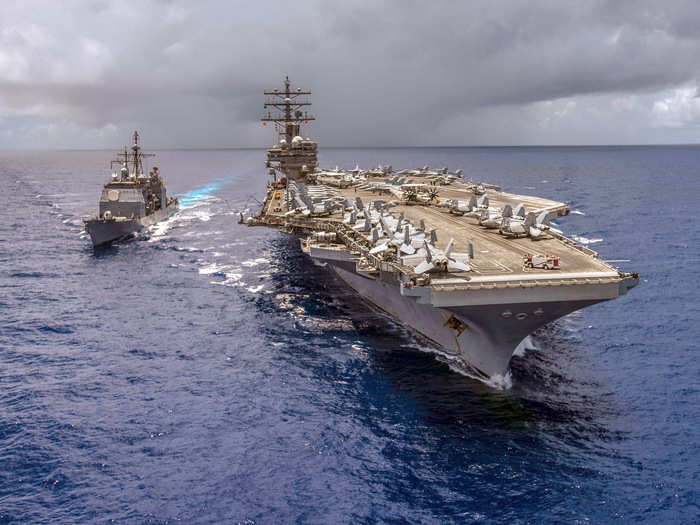- Home
- slideshows
- miscellaneous
- US aircraft carriers are the world's most powerful ships and are nearly impossible to kill - here's why
US aircraft carriers are the world's most powerful ships and are nearly impossible to kill - here's why
China can bring a lot of firepower to a fight.

US carriers are behemoths that built to take a hit.

Displacing more than 100,000 tons, the US Navy's Nimitz-class aircraft carriers are among the largest warships ever built. Their ability to take a beating "is a function of both their size and the compartmentalization of the carrier," Clark explained.
"In the case of the USS America, the size alone resulted in it being pretty survivable," he said, then calling attention to some other aspects of the powerful ships.
Each carrier has a number of main spaces, which the crew would try to seal off should the carrier take a hit below the waterline, say from a torpedo. The ship is so incredibly large that it would take a number of these compartments filling up with water for the ship to sink.
The type of steel used on the ships also makes them difficult to penetrate, Manvel revealed. "It has an underbottom and side protection of several layers of steel." There are also "voids that allow for warhead gas expansion."
The extra armoring is also designed to keep damages from detonating the ship's weapons magazines, where bombs and missiles are stored.
Additionally, the US Navy pays attention to how it moves weapons around the ship, keeping these bombs and missiles as protected as possible. And, steps have been taken to reduce the number of hot surfaces that could ignite.
There are also a lot of redundant systems, which means that critical systems can be rerouted, making it hard to take out essentials like the propulsion system, which could leave the ship dead in the water. As long as the ship can move, it can retreat if necessary.
"Given enough time and weapons, you can sink a carrier. But, if you have defenses, people doing damage control, and propulsion, the carrier can take damage and drive away to eventually come back," Clark told BI.
US carriers "can take a lick and keep on ticking," Manvel, who taught at the US Naval Academy, explained.
US carriers and their escort ships are armed to the teeth.

Carriers and their escort ships are armed with sonar and torpedoes to prevent the stealthy boats from getting close enough for a torpedo attack. And the battle group is also armed with electronic countermeasures and kinetic interceptors for missile defense. They also have various close-in weapons systems to strike at incoming threats as a last resort.
Submarines are their gravest threat to sinking. Russian subs, for instance, are often armed with 1,000-pound torpedoes that were designed to destroyer carrier groups, and it's conceivable that enough fired at once and on target could sink a carrier.
For just this reason, the US has put a lot of effort into anti-submarine warfare, so US carrier strike groups have "the ability to put weapons on submarine contacts very quickly," Clark told BI. Escort ships can launch torpedoes or rocket-fired torpedoes, and SH-60 helicopters can drop torpedoes or sonobuoys to track submarines.
The US has also put greater emphasis on electronic warfare to prevent US carriers from being actively targeted by enemy missiles. The Chinese could "launch a weapon, but it may not be accurately targeted enough to actually hit" a moving carrier from 1,000 miles away, Clark further explained.
There is also a keen interest in improved missile defense capabilities. "There are lots of ways to shoot it down with kinetic interceptors, like the SM-6, SM-2, Rolling Airframe Missile," he added.
Of course, there is also the air wing, which could include up to sixty fighters, as well as a number of jammers, helicopters, and early warning aircraft. "We have a pretty robust air wing that can go hundreds of miles out to provide a buffer for incoming stuff. It would take a lot to get through that," Manvel argued.
American carriers are never alone in hostile waters.

"It’s important to put the carrier where it is least at risk ... surrounded by the battle group," Manvel said.
US aircraft carriers are surrounded by smaller ships, known as escorts. They sail in carrier strike groups consisting of at least one carrier, one cruiser, and one or two destroyers and capable of unleashing a lot of firepower when needed.
They are exceptionally well defended. "You have to launch hundreds of weapons at the carrier strike group to even get a few of them through," Clark explained. That doesn't mean a strike group can't be overwhelmed, though.
There's a good chance China has the ability to do that. At a recent talk at the Heritage Foundation, Clark explained that China could hurl around 600 missiles downrange at a carrier group, which could, on a good day, down roughly 75 percent of the incoming Chinese weapons.
This, however, creates a dilemma for the Chinese military. The People's Liberation Army has to make the hard decision on how many weapons it will throw away just to knock a carrier out for a few weeks, assuming it has merely been damaged and not sunk.
"Those weapons are gone. They don’t have them for some other part of the fight," Clark said, "Maybe that is worth it to them. Maybe it’s not."
And it's likely in a war that the US would destroy these missiles batteries with bombers and long-range missiles before it sends a carrier into their range.
To strike a killing blow, China has to get close, really close.

China has decent torpedoes, and their submarines are increasingly capable. But whether or not they are good enough to slip past the defenses of a carrier strike group to deliver the kill shot to a US carrier is debatable.
In 2006, a Chinese Song-class submarine reportedly managed to skirt the defenses of the USS Kitty Hawk strike group, surfacing within firing range of the carrier as it sailed through the East China Sea, according to a report by The Washington Times, some of the details of which have been called into question. The incident reportedly caused the US Navy to re-evaluate its approach to Chinese subs.
The US Navy can put a lot of fire on a submarine very quickly, and because submarines tend to be rather slow with limited defenses, the enemy submarine could really only retreat once it was spotted.
"Once a submarine has been detected and you start throwing weapons at it, it pretty much has to leave because it is too slow to evade, it doesn’t have a lot of self-defense, and it doesn’t have the sensors necessary to stand and fight," Clark told BI.
The big question is: will the US Navy strike group be able to spot an enemy submarine before it manages to get a shot off?
Popular Right Now
Popular Keywords
Advertisement